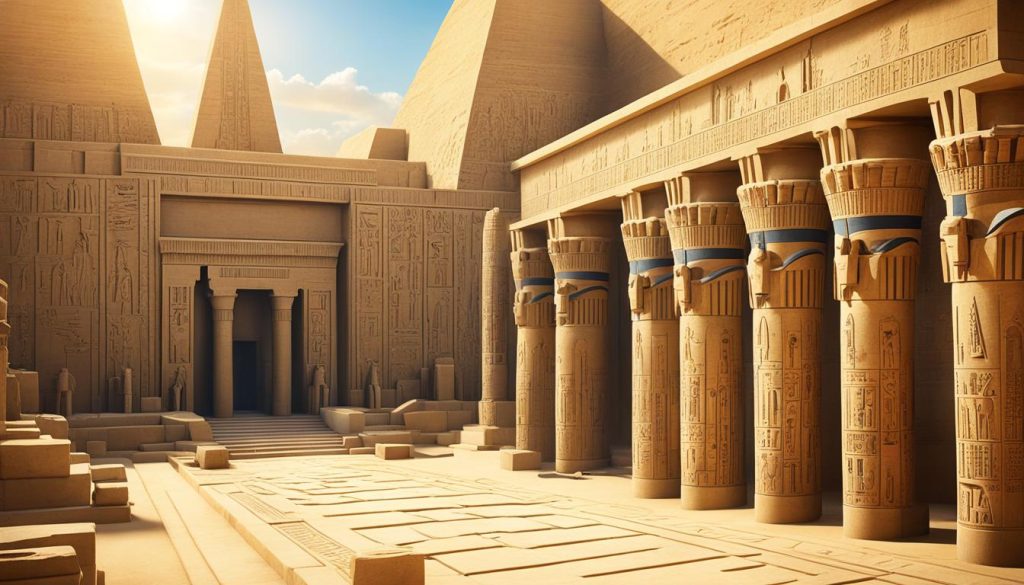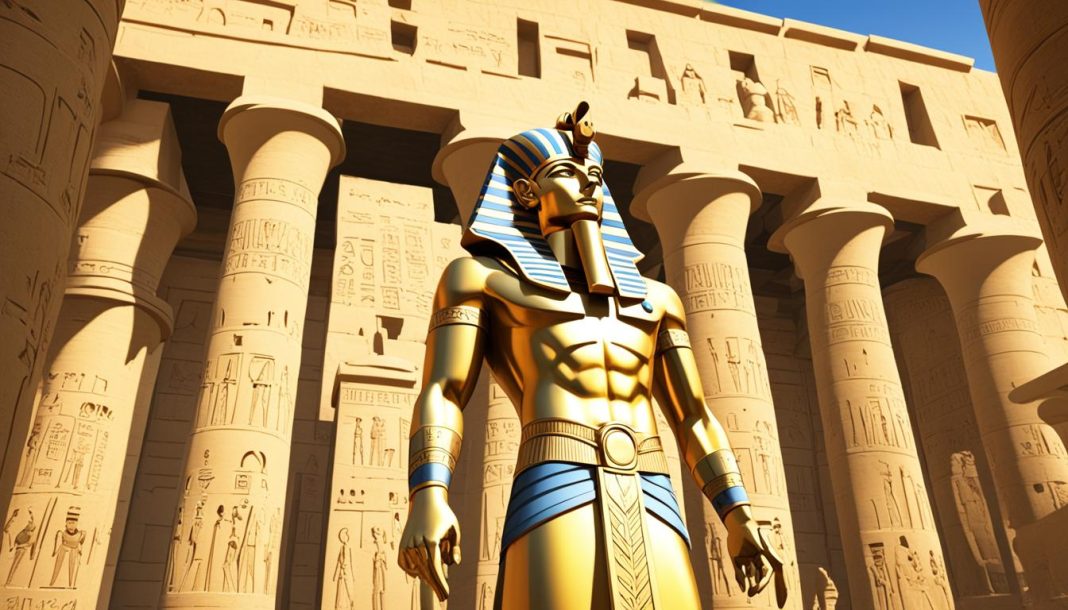Pharaoh Thutmose III, also known as Thutmose the Great, was a mighty ruler of ancient Egypt whose legacy has left a lasting impact on Egyptian history. From transforming Egypt into a conquering nation to leaving an indelible mark on the architectural landscape, Pharaoh Thutmose III achieved remarkable feats that continue to captivate our imagination.
But have you ever wondered: how did Pharaoh Thutmose III shape the course of ancient Egypt? What were his greatest military campaigns and conquests? How did he accumulate immense wealth and influence? And how did his accomplishments in architecture solidify his legacy?
Join us as we delve into the remarkable life and achievements of Pharaoh Thutmose III. From his rise to power and military prowess to his architectural contributions and lasting impact on Egyptian society, we will uncover the captivating story of one of the most influential pharaohs in ancient Egypt.
Key Takeaways:
- Pharaoh Thutmose III transformed Egypt into a conquering nation through his military campaigns and conquests.
- His architectural achievements, such as the constructions at the Karnak temple and the installation of obelisks, showcased his power and piety.
- Pharaoh Thutmose III’s military victories and territorial expansions brought immense wealth and influence to ancient Egypt.
- His legacy extended beyond his lifetime, influencing future generations of Egyptian rulers and earning him the title of the “Napoleon of Egypt.”
- Through artifacts and scarab seals, we can unearth Pharaoh Thutmose III’s achievements and his impact on Western Asia.
Early Life and Rise to Power
Pharaoh Thutmose III’s journey to becoming one of ancient Egypt’s most notable rulers began with his early life and the influence of his stepmother, Hatshepsut. Following the death of Thutmose III’s father, he was too young to ascend the throne, and as a result, Hatshepsut assumed the role of regent. However, her regency eventually developed into her own reign as pharaoh, while Thutmose III received an education and resided in the royal household.
It wasn’t until the death of Hatshepsut that Thutmose III finally stepped into his full power as Pharaoh of Egypt. The regency of Hatshepsut set the stage for Thutmose III’s eventual rise, shaping his understanding of leadership and the complexities of ruling an empire.
“Thutmose III’s early years under the regency of Hatshepsut played a crucial role in his upbringing and prepared him for the challenges he would later face as Pharaoh.”
Military Campaigns and Conquests
Pharaoh Thutmose III, renowned for his military prowess, embarked on a series of remarkable campaigns and conquests, solidifying his status as one of ancient Egypt’s greatest leaders.
Leading expeditions into various regions, including Nubia, Phoenician ports, Kadesh, and the kingdom of Mitanni, Thutmose III expanded Egypt’s territories like no other pharaoh before him. His military campaigns resulted in the creation of the largest empire in Egyptian history, stretching its influence farther than ever.
One of Pharaoh Thutmose III’s most famous battles was the Battle of Megiddo, a testament to his strategic brilliance and tactical acumen. Facing a formidable coalition of opponents, he emerged victorious, dealing a significant blow to their confederation and further cementing Egypt’s dominance in the region.
Thutmose III’s military triumphs not only secured conquered territories but also brought wealth, power, and prestige to ancient Egypt. His military campaigns and conquests played a pivotal role in shaping the history and legacy of the Egyptian empire.
“By overcoming formidable opponents and expanding Egypt’s empire through military might, Pharaoh Thutmose III left an indelible mark on ancient Egypt’s history, forever transforming and solidifying its power in the region.”
The Wealth and Influence of Pharaoh Thutmose III
Pharaoh Thutmose III’s military campaigns not only expanded Egypt’s empire but also brought immense wealth and influence. The spoils of war, including plunder, taxes, and tribute, enriched Egypt’s treasury and made Thutmose III the richest man of his time. Additionally, Thutmose III secured human capital from his conquered lands by bringing the sons of conquered rulers to Egypt to be educated at the royal court. These individuals returned to their homelands sympathetic to Egyptian rule, further strengthening Egypt’s influence.
Architectural Achievements of Pharaoh Thutmose III
Pharaoh Thutmose III, a prominent ruler of ancient Egypt, left a remarkable legacy in the realm of architecture. His visionary projects and grand constructions showcased his power and piety, further solidifying his status as a powerful and influential pharaoh.
One of Thutmose III’s notable architectural achievements was the Temple of Amun at Karnak. Commissioned by the pharaoh, this magnificent temple complex served as a center for religious worship and rituals. Its grandeur and scale reflected the might of the Egyptian empire and the divine authority of the pharaoh.
In addition to the Temple of Amun, Thutmose III also left his mark on the Karnak temple itself. He installed towering obelisks, symbols of power and prestige, within the temple complex. These obelisks served as monumental landmarks and testaments to the pharaoh’s accomplishments, adding a sense of grandeur to the sacred site.
Thutmose III’s architectural endeavors extended beyond Karnak. He also built a temple dedicated to the sun god at Heliopolis, another significant religious site in ancient Egypt. This temple showcased the pharaoh’s religious devotion and further solidified his divine status as a ruler.
The architectural achievements of Pharaoh Thutmose III stand as a testament to his influence and legacy in ancient Egypt. These monumental structures continue to awe and inspire visitors today, offering a glimpse into the remarkable achievements of this powerful pharaoh.

Legacy and Influence of Pharaoh Thutmose III
Pharaoh Thutmose III’s legacy and influence in ancient Egypt extended far beyond his lifetime. Through his military victories and territorial expansions, he established himself as one of the greatest pharaohs in Egyptian history. Thutmose III’s reign laid the foundation for Egypt’s continued dominance in the region and left an indelible mark on future generations of Egyptian rulers.
Thutmose III’s achievements and his reputation as a skilled military strategist earned him the title of the “Napoleon of Egypt.” His successful military campaigns and conquests not only expanded Egypt’s empire but also solidified its power and influence. The conquered territories and tribute brought immense wealth to Egypt, making Thutmose III the richest man of his time.
“Pharaoh Thutmose III’s military successes transformed Egypt into a conquering nation and elevated its status in the ancient world. His influence extended far beyond his lifetime, shaping the course of Egyptian rule and leaving a lasting legacy.” – Dr. Egyptologist
Moreover, Thutmose III’s architectural achievements showcased his power and piety. He commissioned extensive building projects, most notably the construction of the Temple of Amun at Karnak and the installation of obelisks. These architectural marvels not only served as symbols of Pharaoh’s authority but also contributed to the cultural and religious landscape of ancient Egypt.
Pharaoh Thutmose III’s reign as a masterful military leader and visionary ruler laid the groundwork for centuries of Egyptian rule and influence in the region. His legacy as one of the greatest pharaohs in ancient Egypt continues to be studied and admired to this day.
Personal Life and Death of Pharaoh Thutmose III
Not much is known about the personal life of Pharaoh Thutmose III. He had three foreign wives, Menhet, Menwi, and Merti, whom he strategically married to secure loyalty from conquered territories. Thutmose III died in 1425 BC at the age of 56. He was succeeded by his son, Amenhotep II, who continued his father’s legacy.
Contributions to Egyptian Society
Pharaoh Thutmose III, known for his military prowess and conquests, also made significant contributions to Egyptian society beyond his military achievements. He recognized the importance of trade and commerce in fostering economic growth and prosperity for ancient Egypt.
“Trade and commerce played a crucial role in Egypt’s economic development.” – Pharaoh Thutmose III
Under Thutmose III’s rule, trade routes were expanded, and Egypt enjoyed thriving commercial relationships with neighboring regions. This resulted in a steady influx of goods and resources, strengthening Egypt’s economy and enhancing its standing in the ancient world.
Furthermore, Pharaoh Thutmose III demonstrated a deep appreciation for architecture and the arts. He oversaw the construction and expansion of magnificent temples and monuments, leaving behind a rich architectural heritage that still impresses and inspires today.
“Great temples and monuments are a testament to the grandeur of Egypt.” – Pharaoh Thutmose III
The temples built under Thutmose III’s patronage, particularly the Karnak temple, stand as remarkable examples of ancient Egyptian architecture and religious devotion. The intricate designs, massive columns, and imposing obelisks symbolize Egypt’s power and reverence for its deities.
In addition to promoting trade and fostering artistic endeavors, Pharaoh Thutmose III recognized the importance of naval power in expanding and protecting Egypt’s influence. He commissioned the building of ships and expanded the Egyptian navy, securing Egypt’s dominance in the region.
“Strong naval forces ensure Egypt’s control over the seas.” – Pharaoh Thutmose III
The Egyptian navy played a vital role in maintaining control over trade routes, protecting Egyptian interests, and projecting power beyond Egypt’s borders. It enabled Egypt to establish and maintain a formidable presence in the Mediterranean and Red Sea regions.
Through his contributions to trade, the construction of temples and monuments, and the expansion of the navy, Pharaoh Thutmose III left an indelible mark on ancient Egypt. His vision and leadership not only elevated Egypt’s prosperity and cultural heritage but also solidified its strength and influence in the ancient world.

Contributions to Egyptian Society
| Contributions | Impact |
|---|---|
| Encouragement of trade and commerce | Stimulated economic growth and enhanced Egypt’s prosperity |
| Construction and expansion of temples and monuments | Left a rich architectural heritage and showcased Egypt’s grandeur |
| Commissioning of ships and expansion of the navy | Secured Egypt’s dominance in trade routes and projected power beyond Egypt’s borders |
Unearthing Thutmose III’s Achievements
A significant amount of archaeological evidence sheds light on the remarkable achievements of Pharaoh Thutmose III and his influential legacy in Western Asia. Among the artifacts discovered, scarab seals bearing his name have been unearthed in various locations such as Israel, Syria, Lebanon, and Jordan. These scarab seals provide tangible proof of the expansive reach of Thutmose III’s empire during ancient times.
The discovery of these scarab seals is a testament to the vast extent of Pharaoh Thutmose III’s dominion and his conquests in Western Asia. The presence of these artifacts in distant regions vividly illustrates the far-reaching influence and power wielded by this ancient Egyptian ruler.
These scarab seals hold great historical significance, offering valuable insights into the reign of Thutmose III and his interactions with the conquered territories in Western Asia. They provide a tangible connection to the past, allowing us to better understand the impact of this mighty pharaoh on the regions he ruled over.
Delving into the Past
“The discovery of scarab seals inscribed with Pharaoh Thutmose III’s name in Western Asia solidifies his historical presence and illuminates his conquests in the region.”
These artifacts hold immense value for historians and archaeologists, as they provide an invaluable glimpse into the ancient world and the reign of Pharaoh Thutmose III. By studying these scarab seals, experts can piece together the intricate details of political and cultural interactions between the Egyptian empire and Western Asia during this era.
The meticulous documentation and preservation of these artifacts enable us to paint a more comprehensive picture of Pharaoh Thutmose III’s accomplishments and shed light on the vast extent of his empire. Through these archaeological discoveries, we gain a deeper understanding of the rich history of ancient Egypt and the influential reign of this remarkable pharaoh.
Conclusion
Pharaoh Thutmose III, one of the most significant pharaohs in ancient Egypt, has left a lasting legacy that has shaped the course of Egyptian history. His military prowess and strategic brilliance were evident in his successful military campaigns and conquests, which expanded Egypt’s empire to unprecedented heights. Thutmose III’s achievements continue to be studied and admired, showcasing his impact on ancient Egypt’s political and military landscape.
In addition to his military achievements, Thutmose III’s influence extended to the architectural realm. His commissioning of monumental structures, such as the Temple of Amun at Karnak and obelisks, exhibited his power and piety. These architectural marvels stand as a testament to his reign and contribute to the rich architectural heritage of ancient Egypt.
Pharaoh Thutmose III’s legacy and influence reverberate throughout Egyptian history. His military conquests, architectural accomplishments, and strategic brilliance have solidified his position as one of the most impactful pharaohs in ancient Egypt. His reign laid the foundation for Egypt’s continued dominance in the region and influenced future generations of Egyptian rulers. The enduring legacy of Pharaoh Thutmose III will forever be remembered as a testament to the power and influence of ancient Egypt.
























